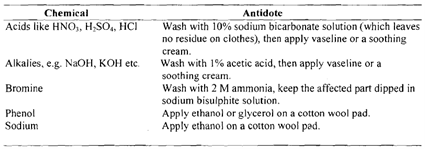Procedures for Treatment of Chemical Burns : Accidental splashing of chemicals onto the skin can produce burns as a result of the corrosive nature of the substance involved. It can also cause skin disorders such as dermatitis. Examples of chemicals which could cause burns are as follows: phenol, bromine, strong acids (especially concentrated sulphuric acid, nitric acid), strong bases (sodium hydroxide (caustic soda) and potassium hydroxide) etc. The standard first-aid treatment for chemical burns is the same as that for dealing with splashes of poisons or other potentially hazardous chemicals on the skin.
The procedure is as follows:
(1) Drench the affected area with large amounts of running water. Continue for at least five minutes or until you are satisfied that the chemical does not remain in contact with the skin. Chemicals known to be insoluble in water can be removed with soap under a running tap. In cases where the water supply is limited, it is best to wipe as much as possible of the acid or other corrosive liquid from the skin quickly with clean cloth before using the little water which is available to wash the affected area.
(2) Carefully remove all contaminated clothing.
(3) The effects of burns from acids, alkalies, bromine, phenol or sodium are considerably reduced and the accompanying pain is lessened by applying an antidote to remove or neutralize the substances.
(4) If the casualty is seriously injured or if the burn was caused by splashes of hydrogen fluoride or other extremely dangerous substances, arrange immediate transportation to the nearest doctor.
Immediate and plentiful dilution is the most desirable action for many "skin contact" accidents with chemicals - particularly for concentrated sulphuric or nitric acids. In fact, water alone, is increasingly recommended for all types of burns. Don't underestimate the penetration effects; phenol can kill through penetration.
Table : Antidotes for Some Chemical Reagents
